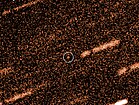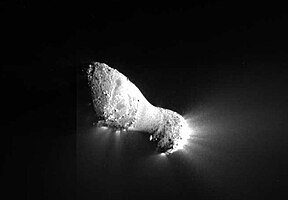
Back Naby-aarde-voorwerp Afrikaans أجرام قريبة من الأرض Arabic Eadnohes Objekt BAR Калязямны аб’ект Byelorussian Близкоземни астрономически обекти Bulgarian Objecte proper a la Terra Catalan تەنەکانی نزیک زەوی CKB Erdnahes Objekt German Γεωπλήσια αντικείμενα Greek Apud-tera objekto Esperanto
| Near-Earth object | |
|---|---|
Radar image of (388188) 2006 DP14 recorded by a DSN antenna Nucleus of near-Earth comet 103P/Hartley as seen by NASA's Deep Impact probe | |
| Characteristics | |
| Type | Small Solar System body |
| Found | within 1.3 AU from the Sun |
| External links | |
A near-Earth object (NEO) is any small Solar System body orbiting the Sun whose closest approach to the Sun (perihelion) is less than 1.3 times the Earth–Sun distance (astronomical unit, AU).[2] This definition applies to the object's orbit around the Sun, rather than its current position, thus an object with such an orbit is considered an NEO even at times when it is far from making a close approach of Earth. If an NEO's orbit crosses the Earth's orbit, and the object is larger than 140 meters (460 ft) across, it is considered a potentially hazardous object (PHO).[3] Most known PHOs and NEOs are asteroids, but about 0.35% are comets.[1]
There are over 34,000 known near-Earth asteroids (NEAs) and over 120 known short-period near-Earth comets (NECs).[1] A number of solar-orbiting meteoroids were large enough to be tracked in space before striking Earth. It is now widely accepted that collisions in the past have had a significant role in shaping the geological and biological history of Earth.[4] Asteroids as small as 20 metres (66 ft) in diameter can cause significant damage to the local environment and human populations.[5] Larger asteroids penetrate the atmosphere to the surface of the Earth, producing craters if they impact a continent or tsunamis if they impact the sea. Interest in NEOs has increased since the 1980s because of greater awareness of this risk. Asteroid impact avoidance by deflection is possible in principle, and methods of mitigation are being researched.[6]
Two scales, the simple Torino scale and the more complex Palermo scale, rate the risk presented by an identified NEO based on the probability of it impacting the Earth and on how severe the consequences of such an impact would be. Some NEOs have had temporarily positive Torino or Palermo scale ratings after their discovery. Since 1998, the United States, the European Union, and other nations have been scanning the sky for NEOs in an effort called Spaceguard.[7] The initial US Congress mandate to NASA to catalog at least 90% of NEOs that are at least 1 kilometre (0.62 mi) in diameter, sufficient to cause a global catastrophe, was met by 2011.[8] In later years, the survey effort was expanded[9] to include smaller objects[10] which have the potential for large-scale, though not global, damage.
NEOs have low surface gravity, and many have Earth-like orbits that make them easy targets for spacecraft.[11][12] As of April 2024[update], five near-Earth comets[13][14][15] and six near-Earth asteroids,[16][17][18][19][20] one of them with a moon,[20] have been visited by spacecraft. Samples of three have been returned to Earth,[21][22] and one successful deflection test was conducted.[23] Similar missions are in progress. Preliminary plans for commercial asteroid mining have been drafted by private startup companies, but few of these plans were pursued.[24]
- ^ a b c Cite error: The named reference
neo-jpl-statswas invoked but never defined (see the help page). - ^ Cite error: The named reference
CNEOS-NEO-groupswas invoked but never defined (see the help page). - ^ Cite error: The named reference
CHAPMAN04was invoked but never defined (see the help page). - ^ Monastersky, Richard (March 1, 1997). "The Call of Catastrophes". Science News Online. Archived from the original on March 13, 2004. Retrieved January 26, 2024.
- ^ Rumpf, Clemens M.; Lewis, Hugh G.; Atkinson, Peter M. (March 23, 2017). "Asteroid impact effects and their immediate hazards for human populations". Geophysical Research Letters. 44 (8): 3433–3440. arXiv:1703.07592. Bibcode:2017GeoRL..44.3433R. doi:10.1002/2017gl073191. ISSN 0094-8276. S2CID 34867206.
- ^ Cite error: The named reference
tsr20120514was invoked but never defined (see the help page). - ^ Cite error: The named reference
spaceguard-2004was invoked but never defined (see the help page). - ^ Cite error: The named reference
pia14734was invoked but never defined (see the help page). - ^ Cite error: The named reference
law-109-155was invoked but never defined (see the help page). - ^ Cite error: The named reference
ETechwas invoked but never defined (see the help page). - ^ Cite error: The named reference
USAToday-NEAwas invoked but never defined (see the help page). - ^ Cite error: The named reference
wired20130323was invoked but never defined (see the help page). - ^ Cite error: The named reference
TaskForceReportwas invoked but never defined (see the help page). - ^ Cite error: The named reference
DeepImpactHartleywas invoked but never defined (see the help page). - ^ Cite error: The named reference
newsci20160930was invoked but never defined (see the help page). - ^ Cite error: The named reference
Eros-NEARwas invoked but never defined (see the help page). - ^ Cite error: The named reference
Toutatis-Changewas invoked but never defined (see the help page). - ^ Cite error: The named reference
Spacecom-Hayabusa2-2019was invoked but never defined (see the help page). - ^ Cite error: The named reference
space-osiris-overviewwas invoked but never defined (see the help page). - ^ a b Cite error: The named reference
NASA220927was invoked but never defined (see the help page). - ^ Cite error: The named reference
BBC-Hayabusa2was invoked but never defined (see the help page). - ^ Cite error: The named reference
space-osiris-samplewas invoked but never defined (see the help page). - ^ Cite error: The named reference
NASA221215was invoked but never defined (see the help page). - ^ Cite error: The named reference
Forbes210831was invoked but never defined (see the help page).
© MMXXIII Rich X Search. We shall prevail. All rights reserved. Rich X Search


